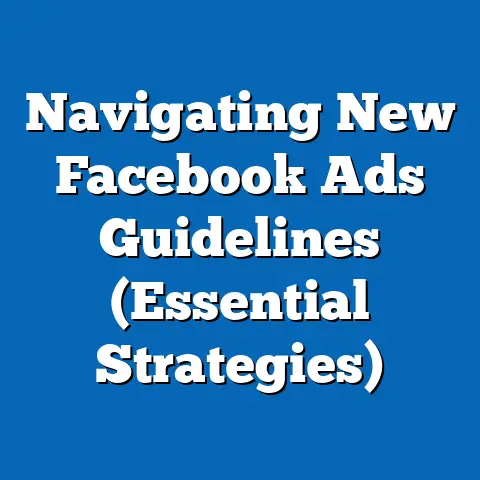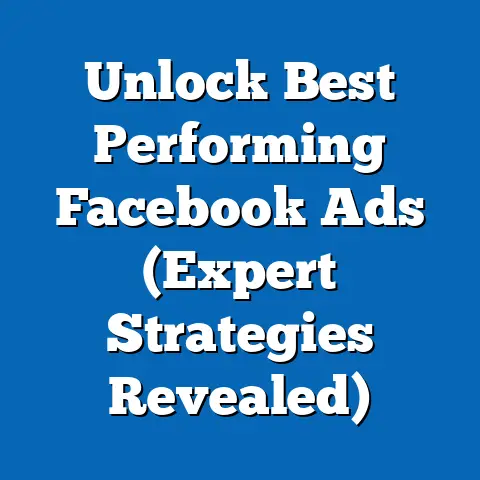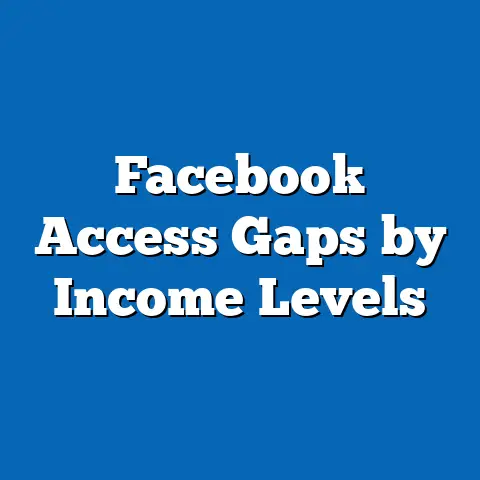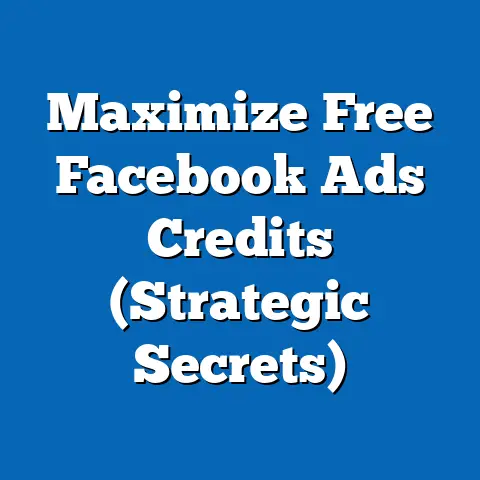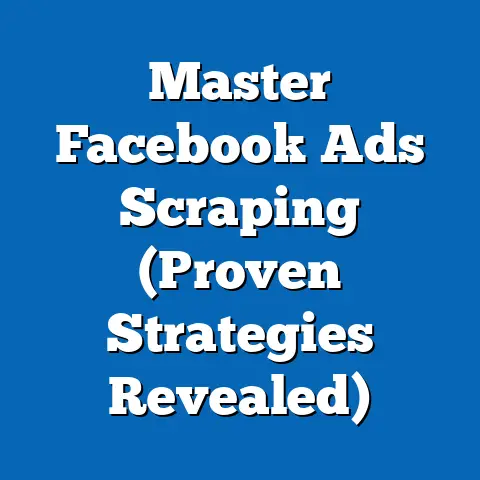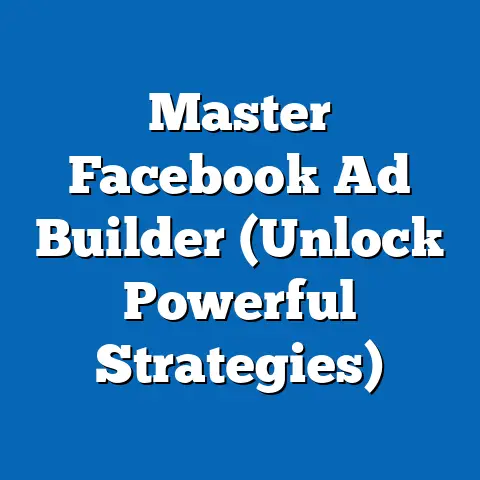Maximize ROI with Bonus Facebook Ads (Profit-Boosting Strategies)
Have you ever felt like you’re throwing money into a black hole with your Facebook ads? You follow all the best practices, diligently target your audience, and craft what you think are compelling creatives, yet the return on investment (ROI) just isn’t there. I’ve been there. I remember spending countless hours tweaking campaigns, poring over data, and feeling utterly frustrated when the results were mediocre at best. It felt like everyone else was cracking the code, and I was stuck on the outside looking in.
The truth is, while the fundamentals of Facebook advertising are crucial, they’re often just the tip of the iceberg. There are lesser-known, “bonus” strategies that can truly unlock the platform’s potential and dramatically enhance your advertising outcomes. These aren’t magic bullets, but rather a collection of advanced tactics, data-driven insights, and creative approaches that, when implemented correctly, can transform your Facebook ads from cost centers into profit generators.
Understanding ROI in Facebook Advertising
Before diving into the “bonus” strategies, it’s crucial to establish a solid foundation by understanding what ROI truly means in the context of Facebook advertising. It’s more than just making a sale; it’s about understanding the long-term value you’re getting from your ad spend.
What is ROI?
ROI, or Return on Investment, is a financial metric that measures the profitability of an investment relative to its cost. In simple terms, it tells you how much money you’re making for every dollar you spend. For Facebook advertising, ROI is calculated as:
(Revenue Generated from Ads – Cost of Ads) / Cost of Ads * 100
For example, if you spend $1,000 on Facebook ads and generate $3,000 in revenue, your ROI would be:
(($3,000 – $1,000) / $1,000) * 100 = 200%
This means you’re making $2 for every $1 spent. A positive ROI indicates a profitable campaign, while a negative ROI signals that you’re losing money.
Why ROI Matters
Understanding ROI is paramount for several reasons:
- Budget Allocation: Knowing which campaigns and strategies are delivering the highest ROI allows you to allocate your budget effectively, focusing on what works and cutting what doesn’t.
- Strategic Decision-Making: ROI provides valuable insights into the effectiveness of your targeting, creatives, and bidding strategies, enabling you to make informed decisions about future campaigns.
- Justifying Ad Spend: Demonstrating a positive ROI allows you to justify your advertising expenses to stakeholders and secure continued investment in Facebook ads.
- Long-Term Growth: By continuously optimizing for ROI, you can build a sustainable and profitable advertising strategy that drives long-term growth for your business.
I remember working with a client who was skeptical about the value of Facebook ads. They had tried it before with limited success and were hesitant to invest further. However, by meticulously tracking their ROI and making data-driven optimizations, we were able to demonstrate a significant return on their investment, which ultimately convinced them to increase their ad spend and scale their business.
Key Metrics for Measuring ROI
While the overall ROI calculation provides a top-level view, it’s essential to track several key metrics to gain a deeper understanding of your ad performance:
- Cost-Per-Click (CPC): This metric measures the cost you pay each time someone clicks on your ad. A lower CPC indicates that your ads are resonating with your target audience and that your bidding strategy is effective.
- Conversion Rate: This metric measures the percentage of people who click on your ad and then complete a desired action, such as making a purchase, filling out a form, or signing up for a newsletter. A higher conversion rate indicates that your landing page and offer are compelling and relevant to your audience.
- Customer Lifetime Value (CLTV): This metric estimates the total revenue you can expect to generate from a single customer over the course of their relationship with your business. Understanding CLTV allows you to make more informed decisions about how much you’re willing to spend to acquire a new customer through Facebook ads.
- Click-Through Rate (CTR): This metric measures the percentage of people who see your ad and click on it. A higher CTR indicates that your ad creative and targeting are effective in capturing attention and generating interest.
- Cost Per Acquisition (CPA): This metric measures the total cost of acquiring a new customer through your Facebook ads. A lower CPA indicates that your campaigns are efficient and cost-effective.
Influencing Advertising Strategies with ROI
A strong understanding of ROI can significantly influence your advertising strategies and decision-making. For instance, if you discover that a particular audience segment is consistently delivering a higher ROI than others, you can allocate more of your budget to targeting that segment. Similarly, if you find that a specific ad creative is generating a lower ROI, you can replace it with a more effective alternative.
By continuously monitoring and analyzing your ROI, you can identify areas for improvement and make data-driven adjustments to your campaigns, ultimately driving better results and maximizing your return on investment.
Takeaway: ROI is the ultimate measure of success for your Facebook advertising efforts. By understanding how to calculate and interpret ROI, you can make informed decisions about your budget allocation, targeting, creatives, and bidding strategies, ultimately driving better results and maximizing your return on investment.
The Power of Audience Targeting
One of the most significant advantages of Facebook advertising is its unparalleled audience targeting capabilities. It’s not enough to simply throw money at the platform and hope for the best. To truly maximize your ROI, you need to understand the power of audience segmentation and targeting.
Why Audience Segmentation Matters
Audience segmentation involves dividing your target market into smaller, more homogenous groups based on shared characteristics, such as demographics, interests, behaviors, and purchase history. This allows you to tailor your ads to the specific needs and preferences of each segment, increasing their relevance and effectiveness.
Think of it like this: you wouldn’t use the same message to sell baby products to college students as you would to new parents. By segmenting your audience, you can create more targeted and personalized ads that resonate with each group, leading to higher engagement and conversions.
Facebook’s Audience Targeting Features
Facebook offers a wide range of audience targeting features that allow you to reach your ideal customers with precision:
- Core Audiences: These are audiences you create based on demographics (age, gender, location), interests (hobbies, passions), and behaviors (purchase history, online activity).
- Custom Audiences: These are audiences you create using your own data, such as email lists, website visitors, or app users. This allows you to retarget people who have already interacted with your business.
- Lookalike Audiences: These are audiences that Facebook creates based on the characteristics of your existing customers. This allows you to reach new people who are likely to be interested in your products or services.
- Detailed Targeting: This feature allows you to further refine your targeting by layering on additional demographic, interest, and behavior criteria.
I once worked with a local bakery that was struggling to attract new customers. By leveraging Facebook’s detailed targeting options, we were able to identify and target specific groups of people who were interested in baking, desserts, and local food. We then created ads that showcased the bakery’s unique offerings and promoted special deals for these targeted groups. As a result, the bakery saw a significant increase in foot traffic and sales.
Advanced Targeting Strategies
To truly unlock the power of audience targeting, you need to go beyond the basics and explore some advanced strategies:
- Layered Targeting: Combine multiple targeting options to create highly specific audiences. For example, you could target people who are interested in both fitness and healthy eating, or people who are parents and also interested in travel.
- Exclusion Targeting: Exclude certain audiences from your targeting to avoid wasting ad spend on people who are unlikely to convert. For example, you could exclude existing customers from your lead generation campaigns.
- Behavioral Targeting: Leverage Facebook’s behavioral targeting options to reach people based on their online activity, such as their purchase history, device usage, or travel habits.
- Interest Expansion: Allow Facebook to automatically expand your targeting to reach people who are similar to your target audience but may not have explicitly expressed an interest in your products or services.
The Crucial Role of Retargeting
Retargeting is a powerful strategy that allows you to show ads to people who have already interacted with your business, such as visiting your website, watching your videos, or engaging with your Facebook page. This is crucial because people who have already shown interest in your business are more likely to convert.
I’ve found retargeting to be incredibly effective in boosting ROI. For example, I often create retargeting campaigns that show ads to people who have abandoned their shopping carts on an e-commerce website. These ads remind them of the products they left behind and offer them a discount to encourage them to complete their purchase. This simple strategy can often recover a significant percentage of abandoned carts and generate a substantial increase in sales.
Takeaway: Audience targeting is the cornerstone of successful Facebook advertising. By understanding the power of audience segmentation and leveraging Facebook’s advanced targeting features, you can create highly relevant and personalized ads that resonate with your ideal customers, driving higher engagement and conversions.
Crafting Compelling Ad Creatives
Even with the most precise targeting, your ads will fall flat if your creative isn’t compelling. High-quality ad creatives are essential for capturing attention, driving engagement, and ultimately, boosting your ROI.
The Significance of Ad Creatives
Ad creatives are the visual and textual elements that make up your Facebook ads. They include images, videos, headlines, descriptions, and calls to action. These elements work together to grab the viewer’s attention, communicate your message, and persuade them to take action.
Think of your ad creative as your first impression. You have just a few seconds to make a positive impact and convince the viewer to learn more about your business. If your creative is dull, irrelevant, or poorly designed, people will simply scroll past it, wasting your ad spend.
Elements of Effective Ad Creatives
To create compelling ad creatives that drive results, focus on the following elements:
- Visuals: Use high-quality images or videos that are visually appealing and relevant to your target audience. Avoid using generic stock photos or low-resolution images.
- Headlines: Craft attention-grabbing headlines that clearly communicate the value proposition of your offer. Use strong verbs and compelling language to entice people to click.
- Descriptions: Write concise and persuasive descriptions that expand on your headline and provide additional details about your product or service.
- Calls to Action (CTAs): Use clear and actionable CTAs that tell people exactly what you want them to do, such as “Shop Now,” “Learn More,” or “Sign Up.”
I always prioritize high-quality visuals in my ad creatives. I’ve found that using professional photos or videos that showcase the product or service in action can significantly increase engagement and conversions. For example, if you’re selling clothing, use photos of people wearing your clothes in real-life settings rather than just product shots on a white background.
A/B Testing Your Creatives
One of the best ways to determine what resonates best with your target audience is to A/B test different creatives. This involves creating multiple versions of your ad with variations in the visuals, headlines, descriptions, or CTAs, and then running them simultaneously to see which performs best.
For example, you could A/B test two different headlines to see which generates a higher click-through rate. Or, you could A/B test two different images to see which drives more conversions.
By continuously A/B testing your creatives, you can identify the most effective elements and optimize your ads for maximum impact.
Success Stories Through Creative Ad Strategies
I’ve seen firsthand how creative ad strategies can transform ROI. For example, I worked with a local restaurant that was struggling to attract new customers. We created a series of video ads that showcased the restaurant’s delicious food, inviting atmosphere, and friendly staff. We then targeted these ads to people who lived nearby and were interested in dining out. As a result, the restaurant saw a significant increase in reservations and walk-in traffic.
Takeaway: Compelling ad creatives are essential for capturing attention, driving engagement, and boosting your ROI. By focusing on high-quality visuals, attention-grabbing headlines, persuasive descriptions, and clear calls to action, you can create ads that resonate with your target audience and generate results. Don’t forget to A/B test different creatives to identify what works best and continuously optimize your ads for maximum impact.
Leveraging Facebook Ad Formats
Facebook offers a diverse range of ad formats, each with its unique strengths and advantages. Choosing the right ad format can significantly impact your engagement rates and conversions, ultimately affecting your ROI.
The Variety of Facebook Ad Formats
Here’s a rundown of the most popular and effective Facebook ad formats:
- Image Ads: These are simple ads that consist of a single image and accompanying text. They’re a great option for showcasing your products or services in a visually appealing way.
- Video Ads: These ads use video to capture attention and communicate your message. They’re ideal for telling stories, demonstrating product features, or showcasing testimonials.
- Carousel Ads: These ads allow you to display multiple images or videos in a single ad unit. They’re perfect for showcasing a range of products, highlighting different features, or telling a sequential story.
- Collection Ads: These ads are designed for e-commerce businesses and allow you to showcase a catalog of products in a visually appealing way. When someone clicks on a product in the collection, they’re taken directly to your website to make a purchase.
- Slideshow Ads: These ads combine multiple images or videos into a slideshow format. They’re a cost-effective alternative to video ads and can be used to tell a story or showcase a series of products.
- Instant Experience Ads: These are full-screen, mobile-optimized ads that load instantly when someone clicks on them. They’re ideal for creating immersive brand experiences and driving engagement.
- Lead Ads: These ads allow you to collect leads directly within Facebook, without requiring people to visit your website. They’re perfect for generating leads for your sales team or building your email list.
I’ve had great success with carousel ads, especially for e-commerce clients. They allow you to showcase multiple products in a single ad, which can increase click-through rates and conversions. For example, I worked with an online clothing retailer that used carousel ads to showcase their latest collection. Each card in the carousel featured a different outfit, and when people clicked on a card, they were taken directly to the product page on the retailer’s website. This strategy resulted in a significant increase in sales.
Tailoring Ad Formats to Marketing Goals
The key to success with Facebook ad formats is to choose the right format for your specific marketing goals:
- Brand Awareness: Image ads and video ads are great for raising brand awareness and reaching a large audience.
- Lead Generation: Lead ads are ideal for collecting leads directly within Facebook.
- Website Traffic: Image ads, video ads, and carousel ads can be used to drive traffic to your website.
- Sales: Collection ads and carousel ads are effective for showcasing products and driving sales.
- Engagement: Video ads and Instant Experience ads are great for generating engagement and creating immersive brand experiences.
Insights on Ad Format Selection
Here are some additional insights to consider when choosing your ad format:
- Mobile-First: Keep in mind that most Facebook users are on mobile devices, so make sure your ads are optimized for mobile viewing.
- Visual Appeal: Use high-quality visuals that are visually appealing and relevant to your target audience.
- Concise Messaging: Keep your messaging concise and easy to understand.
- Clear CTAs: Use clear and actionable CTAs that tell people exactly what you want them to do.
Takeaway: Facebook offers a diverse range of ad formats, each with its unique strengths and advantages. By choosing the right ad format for your specific marketing goals and optimizing your ads for mobile viewing, visual appeal, concise messaging, and clear CTAs, you can significantly impact your engagement rates and conversions, ultimately boosting your ROI.
Optimizing Ad Budget and Bidding Strategies
Your ad budget and bidding strategies play a crucial role in determining your ROI. It’s not just about how much you spend, but also how you spend it.
Different Budgeting Strategies
Facebook offers two main budgeting options:
- Daily Budget: This allows you to set a fixed amount that you’re willing to spend each day on your ads.
- Lifetime Budget: This allows you to set a total amount that you’re willing to spend over the entire duration of your campaign.
Choosing between a daily budget and a lifetime budget depends on your specific goals and preferences. A daily budget is ideal for campaigns that run continuously, while a lifetime budget is better for campaigns with a fixed end date.
Bidding Strategies on Facebook
Facebook offers several bidding strategies that allow you to control how much you’re willing to pay for each ad impression or click:
- Lowest Cost: This strategy allows Facebook to automatically bid for you, aiming to get the lowest possible cost per result.
- Cost Cap: This strategy allows you to set a maximum cost that you’re willing to pay for each result.
- Target Cost: This strategy allows you to set a target cost that you want to achieve for each result.
- Bid Cap: This strategy allows you to set a maximum bid that you’re willing to pay for each impression or click.
I typically recommend starting with the “Lowest Cost” bidding strategy, as it allows Facebook to optimize your bids automatically. However, if you have a specific cost target in mind, you can experiment with the “Cost Cap” or “Target Cost” strategies.
Dynamic Bidding
Dynamic bidding is a feature that allows Facebook to automatically adjust your bids in real-time based on the likelihood of a conversion. This can help you maximize your ROI by ensuring that you’re only paying for the most valuable impressions and clicks.
For example, if Facebook predicts that someone is highly likely to make a purchase after clicking on your ad, it will automatically increase your bid to ensure that your ad is shown to that person. Conversely, if Facebook predicts that someone is unlikely to convert, it will decrease your bid to avoid wasting ad spend.
Monitoring Ad Performance
It’s crucial to continuously monitor your ad performance and make data-driven adjustments to your budget allocation and bidding strategies. Keep a close eye on metrics such as:
- Cost Per Result: This metric measures the cost you’re paying for each desired action, such as a purchase, lead, or website visit.
- Return on Ad Spend (ROAS): This metric measures the revenue you’re generating for every dollar you spend on ads.
- Click-Through Rate (CTR): This metric measures the percentage of people who see your ad and click on it.
- Conversion Rate: This metric measures the percentage of people who click on your ad and then complete a desired action.
If you notice that a particular campaign or ad set is underperforming, consider adjusting your budget allocation or bidding strategy. For example, you could increase the budget for a campaign that’s delivering a high ROAS or lower the bid cap for a campaign that’s generating a low CTR.
Takeaway: Optimizing your ad budget and bidding strategies is essential for maximizing your ROI. By choosing the right budgeting option, experimenting with different bidding strategies, leveraging dynamic bidding, and continuously monitoring your ad performance, you can ensure that you’re spending your money effectively and driving the best possible results.
Analyzing and Iterating on Ad Performance
The final piece of the puzzle is data analysis. You can’t just set up your ads and forget about them. You need to continuously analyze your ad performance, identify areas for improvement, and iterate on your strategies.
The Importance of Data Analysis
Data analysis is the process of examining your ad performance data to identify trends, patterns, and insights. This information can then be used to refine your Facebook advertising strategies and improve your ROI.
I can’t stress enough how important this step is. You might have a gut feeling about what’s working and what’s not, but the data will always tell the truth. It’s like having a crystal ball that shows you exactly what’s resonating with your audience and what’s falling flat.
Using Facebook Insights and Ads Manager
Facebook provides a wealth of data through its Insights and Ads Manager tools. These tools allow you to track a wide range of metrics, such as:
- Reach: The number of people who saw your ad.
- Impressions: The number of times your ad was displayed.
- Clicks: The number of times people clicked on your ad.
- Conversions: The number of people who completed a desired action after clicking on your ad.
- Cost Per Result: The cost you paid for each desired action.
- Return on Ad Spend (ROAS): The revenue you generated for every dollar you spent on ads.
I recommend regularly reviewing your Facebook Insights and Ads Manager data to identify trends and patterns. Look for insights such as:
- Which audiences are performing best?
- Which ad creatives are generating the most clicks and conversions?
- Which ad formats are driving the highest ROAS?
- Which days of the week and times of day are generating the most engagement?
Key Performance Indicators (KPIs)
Key Performance Indicators (KPIs) are specific, measurable, achievable, relevant, and time-bound metrics that you use to track your progress towards your advertising goals.
Some common KPIs for Facebook advertising include:
- Cost Per Acquisition (CPA): The cost of acquiring a new customer through your ads.
- Return on Ad Spend (ROAS): The revenue you generate for every dollar you spend on ads.
- Conversion Rate: The percentage of people who click on your ad and then complete a desired action.
- Click-Through Rate (CTR): The percentage of people who see your ad and click on it.
By monitoring your KPIs, you can quickly identify areas where you’re succeeding and areas where you need to improve.
Post-Campaign Analysis
After each campaign, conduct a thorough post-campaign analysis to identify what worked well and what didn’t. This involves reviewing your data, identifying key learnings, and documenting your findings.
Here’s a step-by-step process for conducting a post-campaign analysis:
- Gather Your Data: Collect all relevant data from Facebook Insights and Ads Manager.
- Analyze Your Results: Examine your data to identify trends, patterns, and insights.
- Identify Key Learnings: Determine what worked well and what didn’t.
- Document Your Findings: Write down your findings and recommendations for future campaigns.
- Implement Your Learnings: Apply your learnings to your next campaign.
Takeaway: Data analysis is the key to continuous improvement in Facebook advertising. By regularly reviewing your Facebook Insights and Ads Manager data, monitoring your KPIs, and conducting thorough post-campaign analyses, you can identify areas for improvement and iterate on your strategies, ultimately driving better results and maximizing your ROI.
Conclusion
Maximizing your ROI with Facebook ads isn’t about finding a secret shortcut or magic bullet. It’s about understanding the platform, leveraging its features effectively, and continuously optimizing your strategies based on data.
I’ve shared a wealth of information in this guide, covering everything from understanding ROI and audience targeting to crafting compelling ad creatives, leveraging ad formats, optimizing your budget and bidding strategies, and analyzing your ad performance.
By implementing these strategies, you can transform your Facebook advertising approach from a cost center to a profit generator. You can create highly targeted and personalized ads that resonate with your ideal customers, driving higher engagement, conversions, and ultimately, a better ROI.
So, what are you waiting for? Take action today and start implementing these strategies. Watch your profits soar and your business thrive!
Action Item: Choose one strategy from this guide that you haven’t implemented yet and commit to testing it in your next Facebook ad campaign. Track your results and see how it impacts your ROI. You might be surprised by the positive impact it has on your bottom line.

